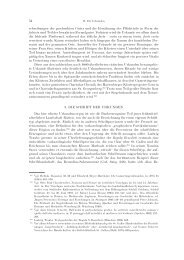Chapter Three ANTHOLOGIES AND ANTHOLOGISTS Between c ...
Chapter Three ANTHOLOGIES AND ANTHOLOGISTS Between c ...
Chapter Three ANTHOLOGIES AND ANTHOLOGISTS Between c ...
You also want an ePaper? Increase the reach of your titles
YUMPU automatically turns print PDFs into web optimized ePapers that Google loves.
126<br />
Part One: Texts and Contexts<br />
composition out of pure modesty. The anthologist must have been a court<br />
dignitary of some importance, for he had access to the imperial archives, where<br />
the numerous hymns composed for performance at the imperial court were<br />
kept. For his anthology he selected only court poetry connected one way or<br />
another with the Macedonian dynasty. There are no ceremonial hymns in<br />
honour of Michael III or Theophilos, although they surely must have existed.<br />
The anacreontic part of his anthology is characterized by the same ideological<br />
bias. There is one poem on caesar Bardas (no. 58) and no less than seven poems<br />
on Basil I, Leo VI and Constantine VII (nos. 30–32 and 36–39). The pro–<br />
Macedonian orientation of the Anthologia Barberina 139 strongly suggests that<br />
the anthologist wished to flatter the reigning emperor by including anacreontics<br />
and hymns celebrating his illustrious forebears. It is therefore very likely<br />
that the anthology was compiled in honour of, or perhaps even on behalf of,<br />
emperor Constantine VII. The anthologist may have presented the manuscript<br />
of the Anthologia Barberina, together with the poem he had written himself, to<br />
Constantine VII on the occasion of the emperor’s marriage to Helen Lekapene.<br />
The index of the Anthologia Barberina reads as a literary history in short. It<br />
rightly begins with Sophronios, the first practitioner of the Byzantine anacreontic.<br />
Then we have three Palestinian poets who followed in his footsteps:<br />
Sophronios Iatrosophistes 140 , Elias Synkellos 141 and Michael Synkellos 142 . In the<br />
early ninth century the anacreontic left its native soil and was brought to<br />
Constantinople by Palestinian émigrés, such as Michael Synkellos. Ignatios the<br />
Deacon was the first Constantinopolitan to write anacreontics, just as he was<br />
the first poet to write classicizing elegiacs after c. 800. The compiler of the<br />
Anthologia Barberina then turns to the poets of his time: AB 28–39 are anacreontic<br />
compositions by Arethas, Leo Choirosphaktes and the anthologist himself.<br />
The next two sections in the Anthologia Barberina (40–57 and 58–64) are<br />
devoted to grammarians of the early sixth and the ninth centuries, respectively.<br />
It is worth noticing that all these poets are called grammatiköß, except for the<br />
arch-grammarian Leo the Philosopher. Thus the compiler of the Anthologia<br />
Barberina, whether correctly or not, connects these poets and their poems to<br />
the Byzantine school system. These products of the Byzantine classroom are<br />
followed by sixteen ancient Anacreontea, perhaps because they were read at<br />
school. These sixteen poems derive from a much larger collection of Anacre-<br />
139 See CRIMI 2001: 46–53.<br />
140 The author should not be confused with his more famous namesake: see TH. NISSEN,<br />
BZ 39 (1939) 349–350. Perhaps he is the Sophronios who used to teach in Edessa around<br />
the year 800: see A. MOFFATT, in: Iconoclasm, ed. A. BRYER and J. HERRIN. Birmingham<br />
1977, 89, n. 32.<br />
141 Elias Synkellos probably lived in the eighth century: see LAUXTERMANN 2003b.<br />
142 On the life of Michael Synkellos (761–846), see CRIMI 1990: 5–11.




